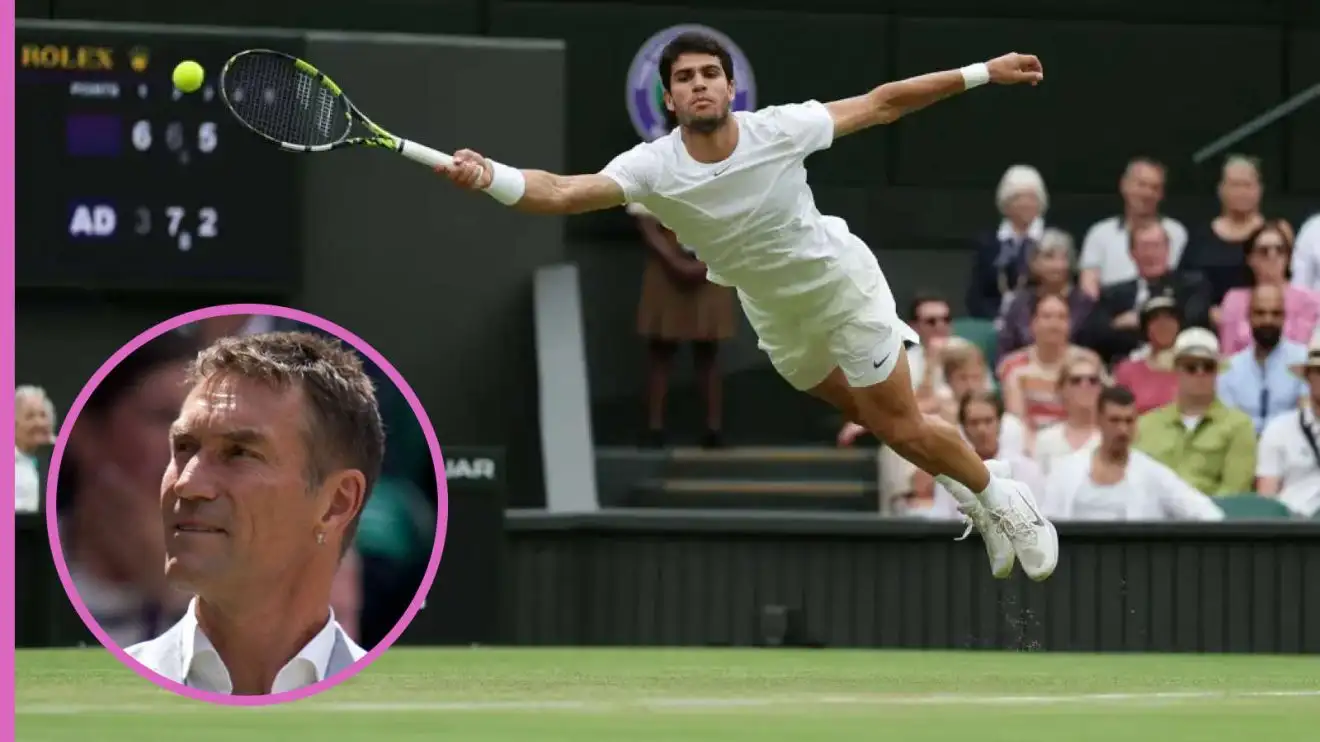
Carlos Alcaraz is quickly establishing himself as one of the greatest grass-court players the tennis world has ever seen, despite having only played 27 top-level matches on the surface. At just 21 years old, the Spanish sensation has already claimed two Wimbledon titles, triumphing in consecutive years (2023 and 2024). His victories both came at the expense of seven-time champion Novak Djokovic, one of the greatest grass-court players in history. Alcaraz’s meteoric rise and success on grass have already drawn high praise, with 1987 Wimbledon champion Pat Cash making a bold declaration: “He is the best player I have ever seen on grass.”
While such a statement might seem premature for someone with just three full grass-court seasons under his belt, Alcaraz’s record speaks volumes. He has amassed a stunning 24-3 win-loss record on grass, winning 89% of his matches on the surface. This statistic is remarkable, especially considering that some of the greatest players in tennis history boast similar or lower success rates on grass over their entire careers. For comparison, Roger Federer, who holds the record for the most Wimbledon titles with eight, compiled a 192-29 record on grass with an 86.9% win rate. John McEnroe, a three-time Wimbledon champion, finished his career with a 121-20 record (85.8%) on grass, while Djokovic, a seven-time Wimbledon champion, has a current grass-court record of 120-20 (85.7%).
These numbers highlight Alcaraz’s early dominance on grass and provide context for why Cash is so effusive in his praise. The Australian tennis legend, who knows a thing or two about playing on grass, believes that Alcaraz has already surpassed the legends of the past in terms of sheer ability on the surface. “He hasn’t got a weakness. I almost think he is one of the best … the best player I have ever seen on grass at his best,” Cash told *Sky Sports Tennis*. “And I am talking about ever seen.”
Cash’s admiration for Alcaraz stems from the way the young Spaniard has synthesized the best qualities of the all-time greats who came before him. He explained how Alcaraz has taken elements from Rafael Nadal’s physicality, Roger Federer’s finesse, and Novak Djokovic’s tactical prowess, creating a complete and formidable package. “He’s taken the best of Rafa, the best of Federer, and he’s been able to adapt that,” Cash said. Alcaraz himself has acknowledged the influence of these legends, particularly Nadal, saying that without Rafa, “I wouldn’t be where I am.” Cash sees this unique combination of skills and influences as a sign that Alcaraz, even at 21, has already achieved a level of mastery on grass that few have reached.
Alcaraz’s ability to seamlessly blend the power of Nadal, the grace of Federer, and the resilience of Djokovic makes him a rare talent in the sport. His athleticism and versatility allow him to play from the baseline with the same authority as Nadal does on clay, yet he can transition to playing at the net with the elegance of Federer. His game is adaptable, as he can stay back and grind out points or step inside the court to attack, much like Federer’s SABR (Sneak Attack by Roger) technique. Cash emphasized how Alcaraz’s game has a fluidity and versatility that makes him stand out: “I have never seen anything like that.”
While Cash’s declaration is bold, not everyone is ready to crown Alcaraz as the greatest grass-court player just yet. British tennis player Liam Broady, who was alongside Cash in the studio during the discussion, acknowledged Alcaraz’s brilliance but offered a more measured view. “I understand what you are saying,” Broady said. “He has the sheer power that Rafa had, but he has the lightness to his game and that sort of aura that Fed had. He’s like a ballet dancer but with that ability to shift like only Rafa could.”
Broady highlighted how Alcaraz combines elements of Nadal’s power and endurance with Federer’s elegance and movement. He pointed out that Alcaraz has the strength to play from deep behind the baseline, much like Nadal on clay, but also the ability to step up and dictate play at the net, similar to Federer’s style. “He is probably one of the few players in the sport who can take your breath away with some of the shots that he hits,” Broady added. “And he can do it four or five times in a match.”
Despite the glowing praise, there is still some caution about placing Alcaraz among the all-time greats too early in his career. Cash himself acknowledged that Alcaraz hasn’t yet had the longevity of players like Federer, Nadal, or Djokovic, who have sustained their excellence for well over a decade. “We will see how he goes throughout his career,” Cash said. “He obviously doesn’t have that longevity yet, but he certainly got the makings of one of the all-time greats with the way he is going.”
As Alcaraz continues to build his career, particularly on grass, the comparisons to the legends of the sport will only grow. With two Wimbledon titles already under his belt and an impressive win-loss record, he is well on his way to carving out his own legacy on the surface. However, as both Cash and Broady pointed out, it will be interesting to see how Alcaraz’s career unfolds over time. Longevity, consistency, and adaptability across different surfaces will ultimately determine whether he can truly be considered the greatest grass-court player of all time. For now, though, the young Spaniard has certainly made an emphatic case as one of the most exciting and dominant forces on grass that the tennis world has seen in years.
Leave a Reply